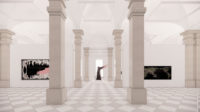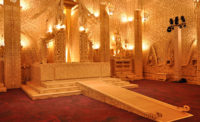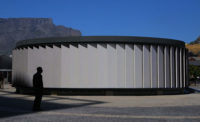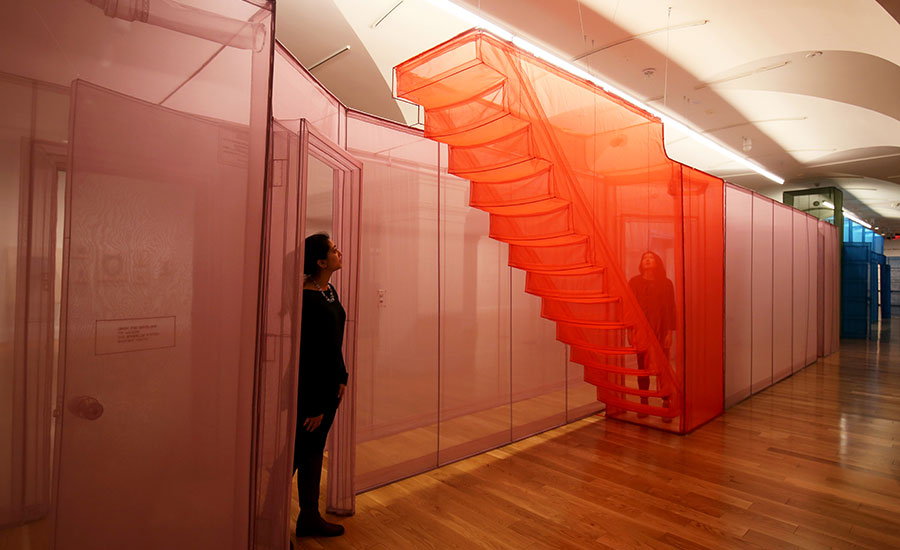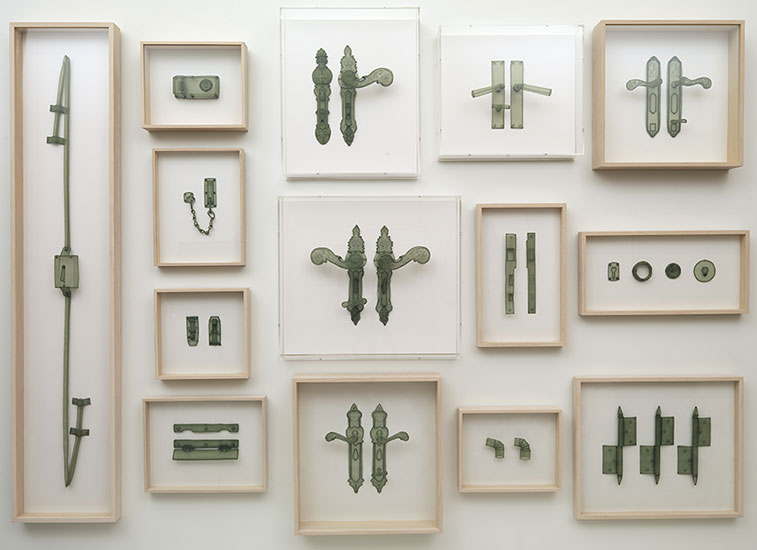‘Almost Home’ by Do Ho Suh Opens at Smithsonian American Art Museum

Installation shot of Do Ho Suh: Almost Home, Smithsonian American Art Museum, 2018
Photo courtesy of the Smithsonian American Art Museum, by Libby Weiler

Installation shot of Do Ho Suh: Almost Home, Smithsonian American Art Museum, 2018
Photo courtesy of the Smithsonian American Art Museum, by Libby Weiler

Installation shot of Do Ho Suh: Almost Home, Smithsonian American Art Museum, 2018
Photo © Deane Madsen

Installation shot of Do Ho Suh: Almost Home, Smithsonian American Art Museum, 2018
Photo © Deane Madsen

Corridor, Wieland Strasse, 18, 12159 Berlin, Germany, 2013, polyester fabric and stainless steel armature, Collection of Nikolaus Hensel © Do Ho Suh
Photo courtesy the artist and Lehmann Maupin, New York and Hong Kong; by Taegsu Jeon

Apartment A, 348 West 22nd Street, New York, NY 10011, USA, 2011, polyester fabric and stainless steel armature, Collection of Ronald and Valery Harrar © Do Ho Suh.
Photo courtesy the artist and Lehmann Maupin, New York and Hong Kong; by Taegsu Jeon

Fire Extinguisher, Unit G5, 23 Wenlock Road, Union Wharf, London, N1 7SB UK, 2016, polyester fabric, stainless steel armature, and display case with LED lighting, Collection of Peter H. Kahng © Do Ho Suh
Photo courtesy the artist and Lehmann Maupin, New York and Hong Kong; by Taegsu Jeon

Close up of Fire Extinguisher, Unit G5, 23 Wenlock Road, Union Wharf, London, N1 7SB UK, 2016, polyester fabric, stainless steel armature, and display case with LED lighting, Collection of Peter H. Kahng © Do Ho Suh
Photo © Deane Madsen

Installation shot of Do Ho Suh: Almost Home, Smithsonian American Art Museum, 2018
Photo courtesy of the Smithsonian American Art Museum, by Libby Weiler

Microwave Oven, Unit2, 348 West 22nd Street, New York, NY 10011, USA, 2015, polyester fabric, stainless steel armature, and display case with LED lighting, Collection of Trey and Jenny Laird © Do Ho Suh.
Photo courtesy the artist and Lehmann Maupin, New York and Hong Kong; by Taegsu Jeon

Radiator, Corridor/Ground Floor, 348 West 22nd Street, New York, NY 10011, USA, 2013, polyester fabric, stainless steel armature, and display case with LED lighting, Collection of the artist © Do Ho Suh.
Photo courtesy the artist and Lehmann Maupin, New York and Hong Kong; by Taegsu Jeon

Close up of Radiator, Corridor/Ground Floor, 348 West 22nd Street, New York, NY 10011, USA, 2013, polyester fabric, stainless steel armature, and display case with LED lighting, Collection of the artist © Do Ho Suh.
Photo © Deane Madsen












Some people who want to remember the places they’ve been collect souvenirs, refrigerator magnets, tchotchkes, or other pocket-sized signifiers of place; others create albums full of photos taken on whatever cameras were available during their stay. Not so for Do Ho Suh, whose ability to recall and reproduce places makes him perhaps the most compelling architectural artist alive.
Suh’s exhibition, “Almost Home,” which opens today at Washington, D.C.’s Smithsonian American Art Museum (SAAM), explores the intersections of space, time, and memory as they relate to the most intimate places he has inhabited. Details rendered perfectly in hand-stitched, translucent fabrics lend an air of absolute authenticity to his “Specimens,” which are ethereal takes on quotidian household objects such as doorknobs, thermostats, circuit breaker boxes, and radiators. These articles—some hardware, some appliances, each more exquisite than the last—line the walls of the exhibition, categorized by the places where Suh lived and observed them.

“My own personal experience of trans-cultural displacement is what motivates my inquiry into the motion of space,” Suh says at the exhibition’s opening lecture. He speaks of his upbringing in Seoul, in a house that was itself a replica of a scholar’s cottage; and of his immigration to the United States at the age of 29, in 1991. He studied at the Rhode Island School of Design, and earned his graduate degree at Yale, before settling in New York, where he lived for 20 years. In those two decades, he began to do rubbings of his dwelling, putting to paper the imprints of the space in which his daughters would learn to crawl as patterns to be cut, stitched, and reassembled into full-scale cloth replicas of that apartment.
These larger-scaled works are what Suh calls “Hubs,” and one that combines his lived spatial experiences on three continents into a single memory corridor anchors the SAAM show. Curator Sarah Newman describes Suh’s work as transcending biography; he transforms memories of his homes into habitable spaces that are site-specific despite having been removed from their respective sites.

“I take the site-specific piece out of its site, fold and pack it in a suitcase, and expose it in another larger and unrelated location,” Suh says. “That specificity becomes highly translatable and transportable—I could carry my home with me wherever I go, like a snail that carries a shell.”
The exhibition Do Ho Suh: Almost Home runs through August 5, 2018, at the Smithsonian American Art Museum.



